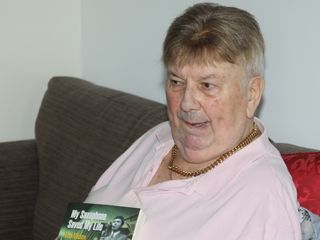Clodagh Meaney: I went to a serial killer exhibition and it was A LOT weirder than I expected
There’s nothing normal about an exhibit featuring the belongings of a cannibal – but it left me with a bad taste in my mouth
Murder memorabilia - or Murderabilia as it’s called - is not a new concept, but it has risen in popularity in tandem with the rise of public interest in true crime.
I first discovered this bizarre phenomenon of people who buy, sell, and collect artefacts relating to famous crimes, killers, and victims when I came across the Instagram account of a store called ‘Cult Collectables’. In particular, they were selling Jeffery Dahmer’s glasses. Yep, the actual glasses worn by the cannibal and serial killer during his three-year stint behind bars before he was murdered in 1994.
The glasses were obtained from the killer’s father Lionel Dahmer, who died himself in 2023. They went on sale for over 143,000 and with not much more than a fleeting thought about the strangeness of it all, I largely forgot about the specs until a new Netflix show about the killer brought them to the mainstream, as the media outlets splashed a story about the specs and the staggering sum the seller, a man named Taylor James.
I soon forgot about the glasses again, but to my surprise, I unexpectedly came face to face with them last weekend.
Down a dark, hidden and graffitied tunnel underneath Waterloo Station in London, a serial killer exhibition world tour has set-up shop in The Vaults.
When I arrived at first I wasn’t quite sure I was in the right place as it wasn’t signposted. But I took my chances and decided to head down the alley and found it straight away. The walls around the tunnel were covered in bright graffiti. A tourist spot in itself, artists entertain visitors with stories of Banksy, giving kids a chance to do some spray painting of their own.
Read more
After a quick bag search, I was on my way inside. The exhibition mixed education and fascination with the macabre in a way that can interest any true crime consumer.
Broken into different sections, visitors go through the exhibit at their own pace. It begins with an explanation of the different types of serial killers; organised or disorganised, and their various motives before we meet our first killer: Jack The Ripper. With educational posters about the Ripper, his victims and the lore surrounding him, there is also a crime scene reconstruction which depicts the killing of Limerick-born sex worker Mary Jane Kelly in 1888.
He, alongside Ted Bundy, Denis Radar, Dennis Nielsen and Ed Kemper all have their own sections about their infamous crimes, while other killers are categorized in sections like Profit Driven Killers, British Serial Killers and Female Killers.
Other areas of the exhibit gave a close up view of execution tools, forensic tools and criminal artwork. There are also reconstructions of John Wayne Gacy’s crawl space, Ed Gein’s sewing room and Anatoly Moskvin’s sitting room.
Dennis Rader's prison slippers and a painting by John Wayne Gacy
What was most fascinating to me, and to most people, was the so-called Murderabilia, which included real artifacts as well as reconstructions.
And this is of course when I came across those damn glasses again. Tucked away in the most stomach churning section of the exhibit among fellow cannibals is a reconstruction of Dahmer’s kitchen - a bloody freezer full of fake human limbs included - as well as the specs, which were safely tucked away in a glass case. Other artefacts belonging to him included his prison bible and letters sent to him from ‘fans’.
British killer Dennis Nielsen also has a pair of his glasses in the exhibit. Other items I perused were Cannibal Armin Meiwes’ actual fridge and freezer, a pearl necklace owned by Doretha Puente, slippers worn by Dennis Rader in prison and crucifixes made by Russian serial killer Vasily Smirnov using bread crumbs.
As well as these, I saw original art by John Wayne Gacy, clothes belonging to Peter Sutcliffe and a guitar signed by Charles Manson.
A lock of hair from Charles Manson, as well as a guitar signed by him
Replicas of The Zodiac Killer’s hood, Israel Keyes’ murder kits and Ted Bundy’s Beetle car were also part of the exhibition, and as strange as it might sound, the most bizarre part of the exhibit came in the form of a killer I had never heard of before; Nicolas Claux.
Posters telling his story surrounded glass cases which featured his artwork - detailed paintings of killers Leonarda Ciancilucci and Alexander Bychov - which were dated 2024. Copies of the books he penned Cannibal Cookbook, Russian Cannibals: Addicted to Human Flesh and The Gospel of Blood also sat behind the glass.
Claux, who is not actually a serial killer, spent seven years of a 12-year sentence behind bars for murdering a man in 1994. When he was arrested, police found bodies in his home, and he was also charged with grave robbing. In an interview, he told police he was a cannibal who had eaten dead bodies at the hospital where he worked in Paris.
By the time I got to his section, I had only recognised his name because various items throughout the exhibit had his name attached. Lain beside a tie worn by The Night Stalker Richard Ramirez during his trial was a note handwritten by Claux. It read: “I clarify I received this necktie from Doreen Ramirez, the ex-wife of Richard Ramirez, in 2017. This is the tie that he was wearing during his Los Angeles trial. Nico Claux.”
I thought maybe I had mixed up the name a little bit, because surely the cannibal killer I was reading about hadn’t provided artefacts belonging to other killers to the exhibit?
Read more
It was then I also noted there was a business card, with an Instagram handle. A cannibal killer… on Instagram? Surely not? My eyes hadn’t deceived me. Nico Claux, as it turns out, is another buyer and seller of murderabilia. It just so happens that he is also a killer.
Out in the gift shop, alongside stickers, magnets and mugs depicting various serial killers, I found a bundle of photos signed by Claux for sale.
How can a killer sell signed photos of themselves - and who is buying them?
Quite like the many murderabilia sellers online, the Serial Killer Exhibition is not completely transparent about their sources either.
Paintings by Nico Claux and photographs signed by him
Are exhibits like this and murderabilia sellers glorifying killers? Or are they simply just a part of crime history, on display for those with an interest in it, the same way those with an interest in history can visit former concentration camps? Or see pieces of ancient history in a museum?
As a student of criminology, and of course a crime reporter, I am completely fascinated by it - and I think it’s human nature to be intrigued by the macabre.
Like everything, it’s nuanced, but I know for sure that I draw the line with murderabilia belonging to victims of crime.
One museum in the United States proudly boasts ownership of toys belonging to a deceased child who was murdered by her mother in Florida in 2008. I have not been to said museum, but I met a curator at an event earlier this year who declined to comment about where and how the item was obtained.
After my visit to the exhibit in London, which is set to close in January, I couldn’t help but chew over just how uncomfortable Nicolas Claux and his link to the exhibit made me feel.










































